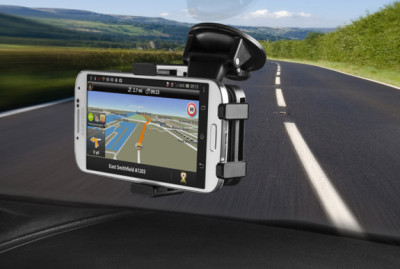Distracted driving has become quite the problem in our society. People just can’t seem to take their eyes and hands off of their phones to focus on anything else–especially driving. But what about using your phone for other tasks, like navigation?
According to a spokesperson for the National Highway Traffic Safety Administration (NHTSA), using your phone for GPS is one of the gray areas of the law and varies from state to state. Many states prohibit texting while driving and several states, like Illinois, can pull over drivers who are even holding phones while driving. Other states, like California, have made exceptions and drivers are allowed to use phones to navigate. It all depends on where you are for the legality of it. But common sense tells a whole other story.
“The primary task of a driver is to be focused on the driving of the car, both hands on the wheel, eyes on the road and being alert of the surroundings,” said José Alberto Uclés, of NHTSA. “So operating, changing or reading an app or a GPS unit in the car is considered a distraction and hence is restricted by law.”
The NHTSA recommends pulling over to operate any GPS system–phone or dedicated–in order to prevent distracted driving. Sounds pretty basic, but sometimes it can be tempting to just punch it in ‘really quick’ and then be on your way. But looking away for even a few seconds can be dangerous while driving. That’s just common sense.
Here are a few tips for driving safely with your cell phone as a GPS:
- For driving with a smartphone for navigation, we recommend purchasing a mount for your phone so you don’t have to hold it—not only is it safer, but you’re less likely to get a ticket. However, windshield mounts are restricted in several states, so be aware of the laws.
- Enable an app like Otter, which will turn off text messages and calls while you’re driving. This will ensure that your navigation isn’t going to be interrupted and you won’t be fiddling with trying to get your map back after a call while on the road.
- Be sure the audio turn-by-turn instructions are on and the volume is up on your phone so you don’t have to look away from the road as often. If your phone navigation doesn’t have voice guidance, find one that does.
- Program everything before you take off, and pull over to enter a new destination.
- When possible, ask your passenger to ‘copilot’ and take over navigation so you can focus on the road.
- Check with your state highway patrol to see if there are any specific laws regarding the use of GPS and phones and be sure to follow them.
Knowing where you are going makes you a safer driver, but using technology in the vehicle can still be quite a risk. Most of these are common sense, but with the statistics rising every year, reminders never hurt. So get out there, enjoy your ride and be safe!


Nice article.
Thanks
What a bunch of controll freaks. Without GPS I could not figure out most of my medical care facilities in Sacramento where parking has always been an issue. There street sighns are gone, lights are not true colors (so many men color blind and need opaque true colors), camers at right turns where the possibility of hitting oncomming traffic is impossible yet you are flashed and blinded then charged 450.00. Who has that much money to throw around to a lazy police force that can’t seem to coralate the lights to the traffic. I need my GPS which I set up on my desktop and send to my smart phone and start it before I put it in gear. If I need to make a change sometimes I will do it at a fresh Red light. It is in the cup holder and all is done by voice comand.
What is wrong with that?